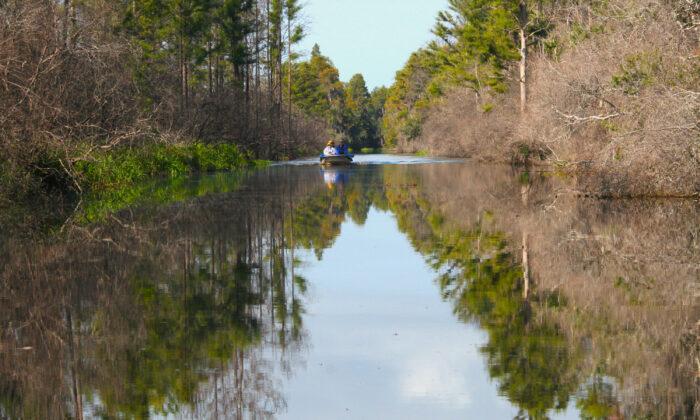Call it what you will — primordial, mystifying, daunting, backwater or, above all, magnificent in that swamp sort of way — the Okefenokee Swamp is one of Georgia’s most beloved treasures. Covering some 700 square miles in southeastern Georgia and the very northern reaches of Florida, the Okefenokee, whose name means “Land of the Trembling Earth” in the Creek language, is now part national wildlife refuge and part privately owned park that is widely known for harboring an incredible cache of biological and ecological wonders.
The swamp’s dark, coffee-colored water is the base for a living jumble of pine, cypress, swamp, palmetto, peat bog, marsh, island and sand ridge. A hodgepodge of animal and bird life — among the hundreds of species are black bear, alligators galore, snakes aplenty, deer, anhinga, osprey, and sandhill crane — call the swamp home.
On a brilliantly blue, cloudless day in spring, a young man named Scott, a local guide and seventh-generation swamper, fires up the motor on a Carolina Skiff as my husband, Roy, and I prepare to take a half-day’s journey into the Okefenokee. The noise startles a great blue heron from the water’s edge into a graceful, slow flight, its lustrous more-gray-than-blue plumage mirroring splendidly against the dark swamp. The gorgeous bird hopscotches across the surface before vanishing into a tangle of trees.
As Scott expertly maneuvers the skiff through the mysterious, mesmerizing waters of the Okefenokee, a beat-up lean-to, an old shack, really, comes into our sights. Scott explains that it is his uncle’s old moonshine still and that “white lightning,” illegal hooch, was still being made in the swamp even after Okefenokee Swamp Park was established in 1946. He says that his uncle would “outsmart” the law by not using firewood, which creates smoke and gives a moonshiner’s location away, and instead using propane, which doesn’t and in a sense creates invisibility.
Eventually it became legal for liquor to be sold in these South Georgia, Southern Baptist counties where the Okefenokee lies, and the secretive art of moonshining disappeared from the swamp. But what remains is an incredible beauty that is the backbone of the swamp, the kind of raw, natural beauty that stirs the soul and the imagination.
One of the most extraordinary facets of the Okefenokee Swamp is its utter quiet — or so you might think. Then little by little, sound by sound, you realize that it’s not really quiet at all. Stand still, and within a few moments birds sing and trill, squirrels scamper and chatter, crickets chirp, bullfrogs croak and gators bellow and dive in a natural orchestra conducted by Mother Nature.
The swamp sweeps across more than 700 square miles, cutting a wide swath of wetlands, uplands, islands and pine forests. Here, it is all about the critters living free in their natural environment.
There is a good explanation of why the Okefenokee is called the “Land of the Trembling Earth.” The ground, mostly a peat bog with some deposits up to about 15 feet thick, is soft and unstable and really does tremble. At one of our boat stops on a watery bird-filled prairie, our guide asks me to step off the boat and into the bog, sans shoes. The day was chilly and windy and I wasn’t thrilled at the prospect of cold, wet feet, but I obeyed nonetheless. When he amusingly tells me to “bounce up and down,” I did as I was told, as you just don’t say no to a backwoods swamper. The ground was vibrating beneath my bare feet, quivering practically, like a giant bowl of jelly, but I quickly bounded back into the boat in case a ‘gator had an eye on me as an entree.
Think of the vast peat bog as a huge saucer-shaped depression, just a 700-square mile bowl full of birds, mammals, amphibians, fish, flowering and nonflowering plants and trees and almost three dozen varieties of snakes, including six that are venomous. Eight-foot long diamondback rattlesnakes have been found in the swamp. The swamp water, as black as a cast iron kettle because of tannic acid released by decaying vegetation, is pristine and pure and shimmers like quicksilver on the cloudless day.
The Okefenokee has faced some serious challenges from Mother Nature in the past couple of decades, including a tinderbox dry, years-long drought followed by two devastating fires that scorched some 800,000 acres. All is well now, the swamp green and verdant, but sometimes you see the blackened bones of trees where the canopied forests once stood. While swamps need occasional fires to keep vegetation down —otherwise they would convert to uplands — the combination of drought and fire turned the ecosystem upside down for a while by driving away birds and wildlife. Over the years, they eventually came slithering, crawling, hopping, prancing, winging, lumbering and leaping back, especially as new growth returned.
The swamp is home to several endangered and threatened species, including the red-cockaded woodpecker, indigo snake and wood stork. At one time, the American alligator, of which the U.S. Fish and Wildlife Service estimates about 15,000 live in the Okefenokee, was listed as endangered but now is prolific across the southern half of the U.S. and because of their now large numbers they are oftentimes considered a nuisance.

One of the biggest gators here was the 14-foot-long Oscar, whose bones rest in the visitor center at Okefenokee Swamp Park near Waycross. He was estimated to be about a hundred years old when he died. Not far up the creek, Scott showed us several alligator nests, assuring us that big ol’ Mama Gator or an Oscar progeny wouldn’t come out because the morning was so cold.
Okefenokee National Wildlife Refuge, which borders Okefenokee Swamp Park, was established in 1936 to safeguard the swamp, one of the oldest and well-preserved freshwater areas in the U.S. No one has lived within its borders since then. Logging was outlawed here in 1934, animal trapping in 1936, and “turpentining,” the gathering of sap or resin from pine trees, was stopped in 1939.






